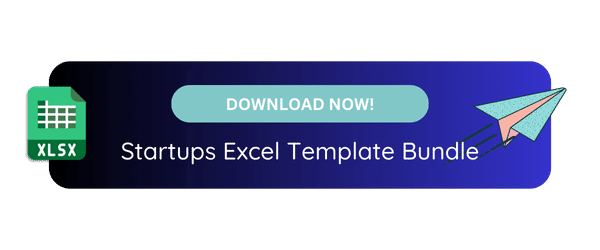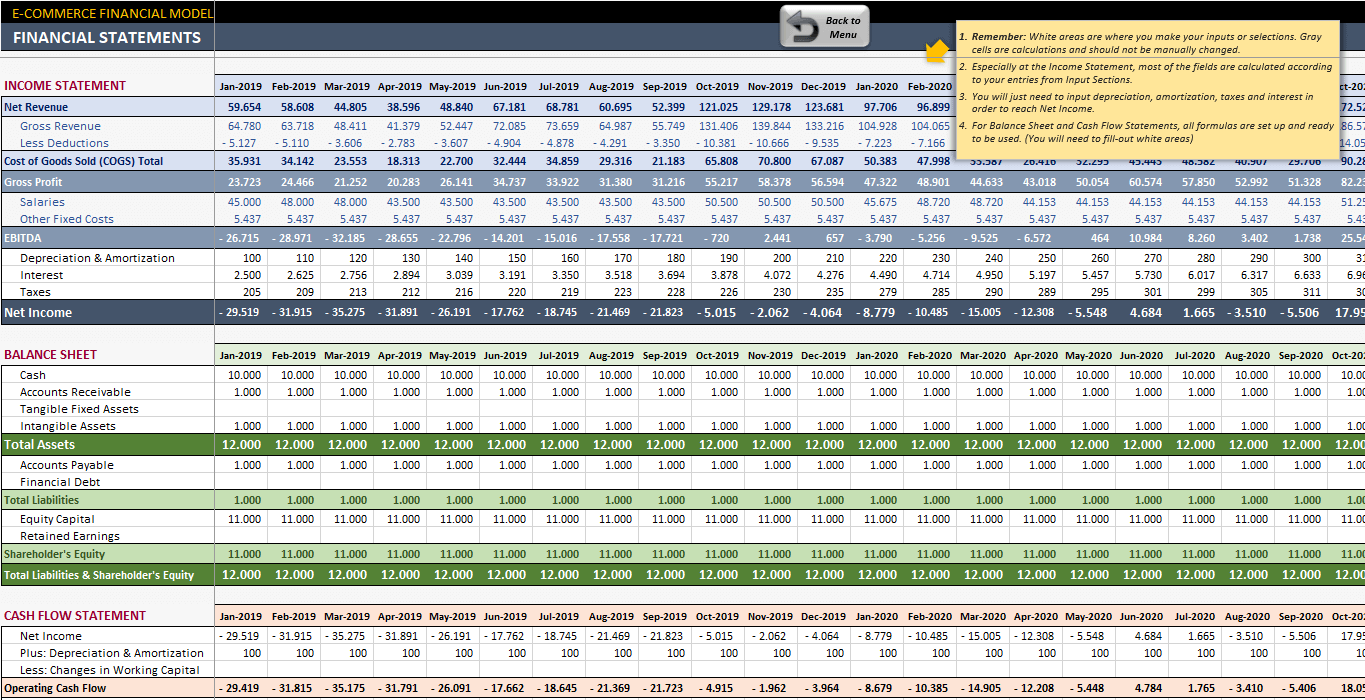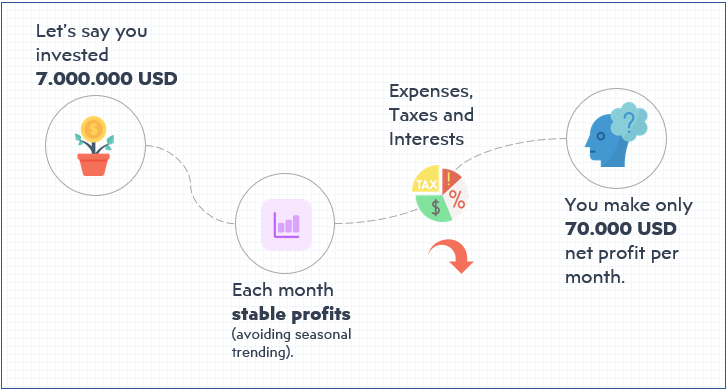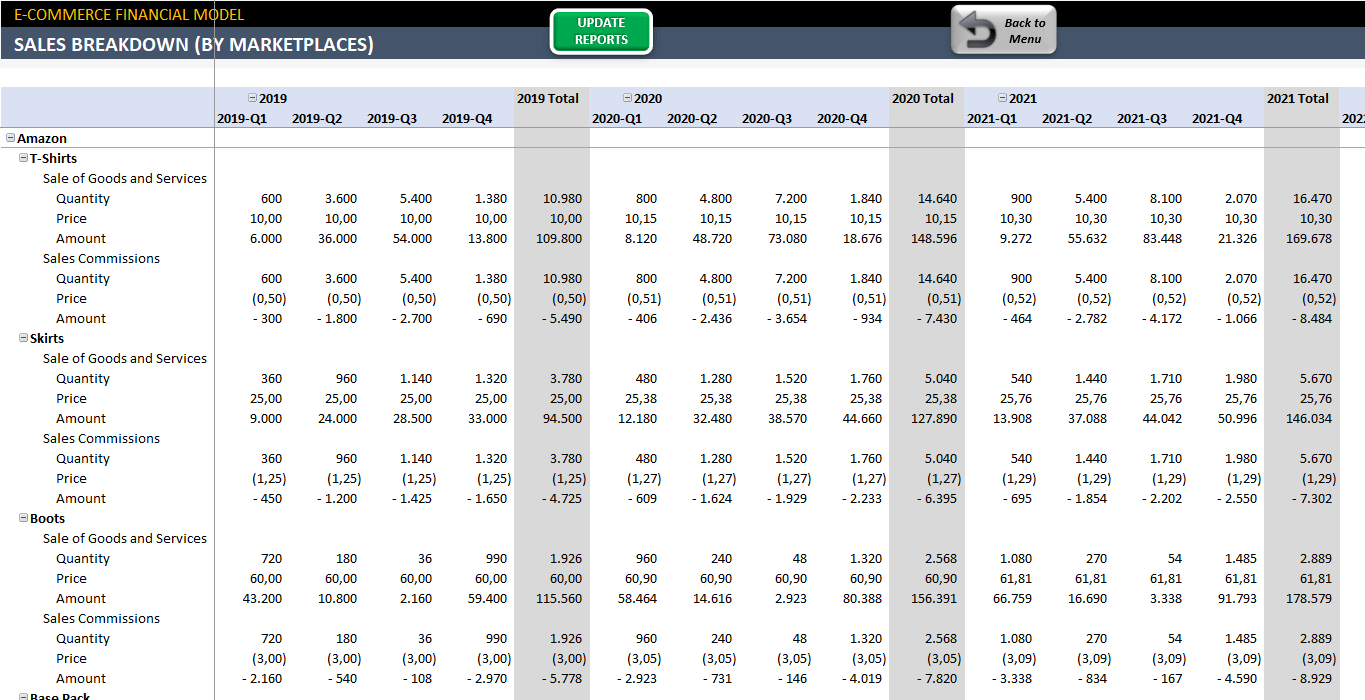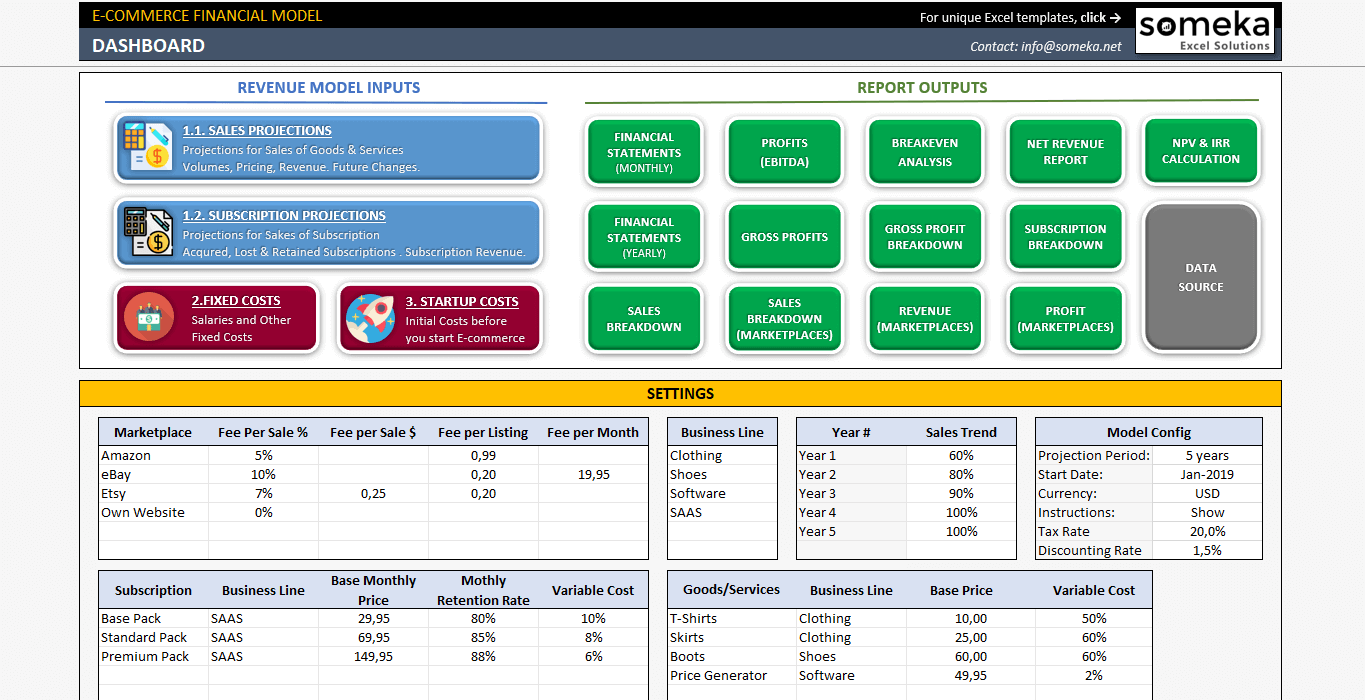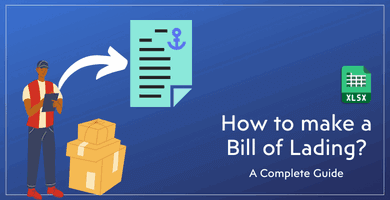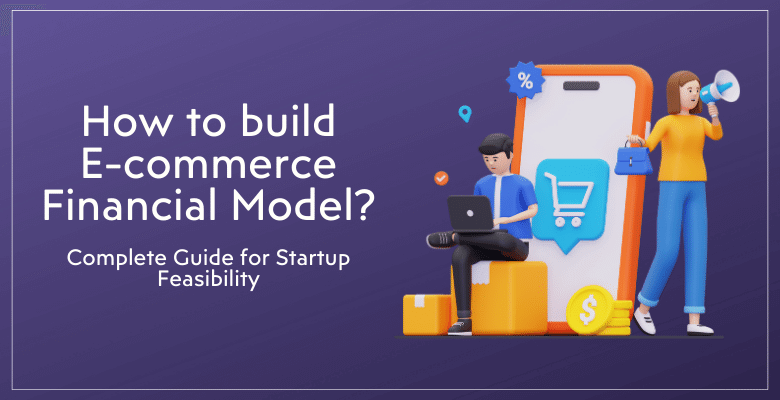
How to Build an Ecommerce Financial Model? A Complete Guide
Before investing in an ecommerce business or startup, you should first question the feasibility of your project. If you do not know where to start, here’s a complete guide on how to build an Ecommerce Financial Model with tips and tricks.
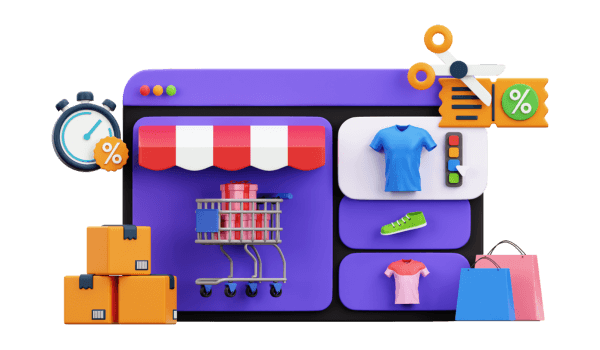
The world of E-Commerce has grown in such a high speed that it creates a huge number of opportunities for entrepreneurs and established companies alike.
Building an effective eCommerce financial model is crucial for earning money in this dynamic industry, forecasting profitability, and ensuring long-term success.
Table Of Content
1. General Overview of Ecommerce Industry
- What does it mean Ecommerce Business?
- What are main elements of ecommerce business?
- What are the 4 types of e-commerce?
- What is an eCommerce Business Model?
2. Feasibility of Ecommerce Business
- Financial Statements
- Break-Even Analysis
- Net Revenue Report
- Sales and Subscription Breakdown
- EBITDA Calculation
- NPV and IRR Calculation
4. Ready-to-use Excel Ecommerce Financial Model
This article provides a comprehensive guide on creating a robust eCommerce financial model, detailing each step from understanding industry dynamics to advanced financial reporting.
1. General Overview of Ecommerce Industry
The Ecommerce industry, characterized by its vast and ever-evolving nature, is a cornerstone of modern global commerce. It encompasses the buying and selling of goods and services using the internet, and extends across various business models.
1.1. What does it mean Ecommerce Business?
Any company that does business on the Internet but does it all electronically is called an E-Commerce business. It includes a lot of different types of online business activities for goods and services.
This can include a lot of different kinds of transactions, like buying things in stores, doing business with other businesses, downloading digital products, and more.
1.2. What are main elements of ecommerce business?
Basically, an eCommerce business uses technology to do business over the internet. It’s different from traditional retail and commercial businesses in that it offers both opportunities and challenges.

So, there are some key concepts in order to fully understand the e-commerce businesses:
- Online Marketing and Advertising: Search Engine Optimization (SEO), content marketing, social media marketing, and online ads are some of the digital marketing strategies that eCommerce businesses use to get new customers and keep the ones they already have.
- Payments Made Electronically: Credit cards, PayPal, and other digital payment services are common ways for people to pay for things online.
- Global Reach: Unlike traditional stores, online stores can sell to people all over the world as long as they have access to the internet.
- Delivery and Logistics: Online shopping includes both digital order processing and physical logistics for delivering goods. This could include keeping track of stock, packing, shipping, and taking care of returns.
Digital customer service features like online support, live chat, and customer relationship management systems are also part of eCommerce.

1.3. What are the 4 types of E Commerce?
We can categorize e-commerce business types according to their seller and buyer type.
-
Business-to-Consumer (B2C):
In this model, the seller is a business like an online store, while the buyer is an individual consumer. For example, an online store could offer custom notebook printing to attract individual consumers looking for personalized products.
-
Business-to-Business (B2B):
In this model both sides are business. This means the e-commerce shop sells products or service to other businesses, not consumers. For example a manufacturer buys from a wholesaler and then sells to a retailer.

-
Consumer-to-Consumer (C2C):
In this model, both sides are consumers. An individual is selling a product or service to consumers. They mostly use marketplaces or social media platforms to find customers for their products. For examples people can sell to each other on websites like eBay or Etsy.
-
Consumer-to-Business (C2B):
In this model, the individuals create value with products or services for businesses. For example, freelance servcies, affiliate marketing, stock photography websites migh be good examples for this model.
1.4. What is an eCommerce Business Model?
An E-Commerce business model defines the method by which a company earns revenue through online sales. This can include direct sales, subscription services, or third-party advertising as part of ecommerce financial model.

The revenue of these e-commerce businesses are calculated as a sum of their direct sales and also subscriptions. So building a dynamic revenue model becomes a little trickly here.
2. Feasibility of Ecommerce Business
Before diving into an ecommerce or startup venture, assessing its feasibility through careful financial planning is essential. Your ecommerce business plan should include a robust forecasting.
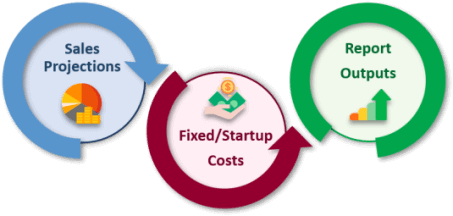
The financial model of the e-commerce business will involve:
- Revenue Projections
- Cost Calculations
- Reports and Analysis
2.1. How to Forecast Revenue in Ecommerce Financial Model?
In e-commerce business, there are two main revenue channels: 1. Direct Sales, 2. Subscriptions.
Sales Projections
Projecting sales involves analyzing market trends, target demographics, and competitive landscape.
You should first make a table for your direct sales.
- List your items, and the market places that you’ll sell those items.
This will bring you ease while calculating your commissions and other fees.
- Add your Base price and Variable Cost rates to the model.
- Now you can make projections on monthly sales numbers.
Then you should add your pricing projections to your model.
According to conjoncturial condisitons, you can make annual, semi-annual, quarterly or monthly price increases to your model.
Subscription Projections
Ecommerce businesses and startups may and should have also subscription models in their revenue channels.
Calculating revenue-based projections are a bit tricky. You should be considering New Subscribers and Monthly Retention Rates.
For example: If you expect 100 new subscribers each month with a retention rate of 80%, then here’s your monthly expected subscriber numbers:
- 1st Month: 100
- 2nd Month: 100 +(100 x 0,80) = 180
- 3rd Month: 100 + (180 x 0,80) = 244
For models based on subscriptions, you’ll also forecast the average subscription fee. You can again select monthly, quarterly, semi-annually or annually price increase trends.
2.2. How to Calculate Costs in Ecommerce Financial Model?
Now it’s time to calculate our expected costs.
In the ecommerce financial model, there three types of costs:
- Startup costs: Initial costs while investing in the venture
- Fixed Costs: Personnel costs, marketing costs, utilities, and other expenses
- Variable Costs: These are the costs related to your production levels.
Startup Costs
These are the initial expenses incurred while setting up the E-commerce business.
In an ecommerce financial model, startup costs may include website development, technical SEO issues, warehouse equipment, computers and other office equipment, initial inventory, software expenses, and likewise initial costs.
In addition, it is necessary to budget for the implementation of technologies such as popup sales, augmented reality, voice search and photo search, as well as marketing costs such as working with influencers.
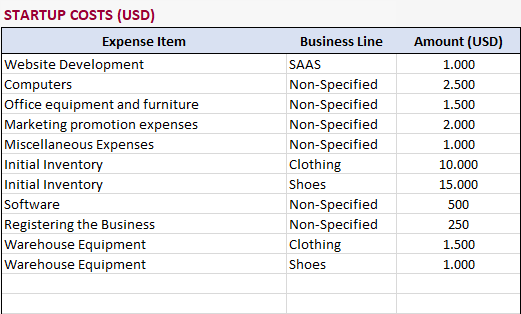
Fixed Costs
These are ongoing expenses that do not change with sales volume. These costs are the ones you’re paying each month.
The fixed costs will include staff expenses (salaries you pay for your team), commissions you pay for marketplaces, and other monthly expenses like office rental, warehouse rental, utilities, marketing, etc.
For the marketplaces you’re active in, you should both calculate the commission expenses and listing expenses.
Variable Costs
Variable costs are calculated based on your sales projection.
- First, identify the variable cost percent for each item.
For example if you say I have a 50% Variable Cost for a certain item, then this means you’ll have a 50$ COGS for every 100$ revenue you get from the sale of that item.
- While calculating your total variable costs, do not forget to add the possible cost increases in your model.
3. Financial Model Reporting
Creating comprehensive financial reports is critical for monitoring the health and progress of an eCommerce business.
So, after forecasting your revenue and costs, now it’s time to analyze the feasibility of your business.
3.1. Financial Statements
This includes:
- Income statement
- Balance sheet
- Cash flow statement
Prepare your three main financial statement models, which will catch data from your revenue and cost projections.
– This is the Financial Statements area of Ecommerce Financial Model Template by Someka –
You can prepare your financial statements in different sheets, or you can use the same sheet.
3.2. Break-Even Analysis
You should now determine the point at which total revenues equal total costs. This is very important to see where your business will start to bring you in a real money.
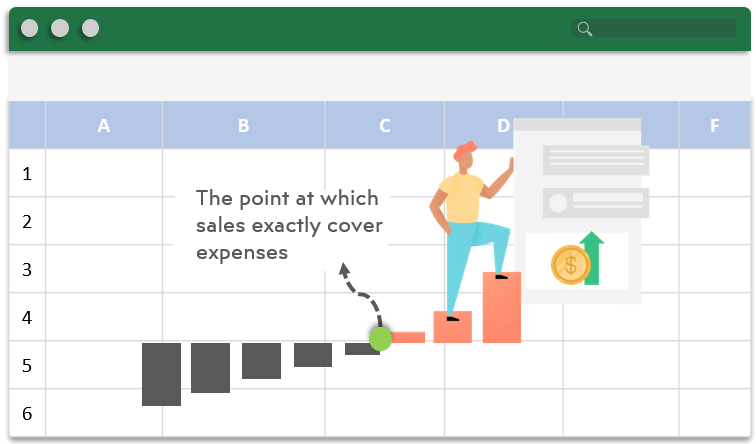
The break-even calculation will be made up on:
- Monthly Revenue Projections
- Initial Startup Costs
- Variable Costs
- Fixed Costs
3.3. Net Revenue Report
A net revenue reporting is a detailed report showing the actual revenue earned after accounting for returns, discounts, and other deductions.
Please always keep in mind that the money you earn from your revenues is not your actual revenue!
3.4. Sales and Subscription Breakdown
You can always make a separate analysis of revenue streams from direct sales and subscriptions. This will give you a general insight about your cash flow:
– This is the Sales Breakdown Marketplace of Ecommerce Financial Model Template by Someka –
You can use pivot tables in Excel to make dynamic analysis on your sales breakdown.
3.5. EBITDA Calculation in Ecommerce Financial Model
EBIDTA is the earnings Before Interest, Taxes, Depreciation, and Amortization (EBITDA) and it provides insight into operational profitability.
It’s the most common kpi while evaluating the profitability of any business.
3.6. NPV and IRR Calculation
Lastly, you can add NPV and IRR calculations on your model.

Net Present Value (NPV) and Internal Rate of Return (IRR) are used for assessing the long-term profitability and investment potential of the eCommerce business.
These rates will help you to evaluate the time value of your investment. Because, the 100$ of today is never the same tomorrow!
4. Ready-to-use Excel Ecommerce Financial Model
Building a successful E Commerce financial model requires a deep understanding of the industry, careful market analysis, and detailed financial forecasting.
You should both have financial knowledge and Excel skills to build such a comprehensive model.
So using a ready to use template will save you time, energy, money and probably will provide you with a more accurate analysis.
Someka has build a financial model special to ecommerce and startup businesses:
– This is the main dashboard of Ecommerce Financial Model Template by Someka –
Provided in Excel, this template allows you to make configurations according to your own needs and then all you have to do is input your data and analyzing the automatic reports.
You do not have to do any calculations.
Such a model is indispensable for decision-making, guiding business strategy, and securing investor confidence.
Recommended Readings:
How Should You Use Microsoft Excel for Your E-Commerce Business?
Overview of Risk Assessment Process: Importance, Steps, and Framework
